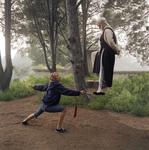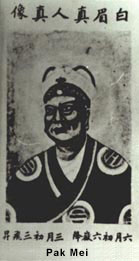July 24, 2004
Pak Mei & Wing Chun
Extraido de http://www.yaolin.com.au/kung_fu/pak_mei/pak_mei.html
Pak Mei History


"Pak Mei existed in the late 1600's during the Ching Dynasty. It was within the walls of Siu Lum Jee (Shaolin Temple) where an anonymous Monk trained and mastered his Kung Fu skills. He was selected with three others - a nun Ng Mui, Jee Shin Shim See and Fung Doe Duk - to learn from a Tibetan Lama who was visiting the Temple at the time. The Manchurians, ruler of China during the Ching Dynasty, suspected a gathering of revolutionaries who wanted to overthrow the Ching government and rebuild the Ming Dynasty.
The Manchurian Emperor sent an army to destroy the rebellions. At that time Ma Lin Yee, a monk who was dismissed from the temple for breaking a precious lamp given by an emperor, became a traitor and gave information to the Manchurians. The attack came as a surprise. Many monks died trying to protect themselves and the burning Temple. 18 monks escaped from the destruction.
But once the Manchurian commander learned about the 18 survivors, he ordered his army to hunt them down, stopping them from spreading their knowledge and their cowardly attack. 13 monks were found and killed, while the 5 survivors travelled to Ngor Mei Mountain. A 3099m high mountain with about 70 monasteries and temples at that time,is the best place to hide from the Manchurians. They took refuge at a Taoist Kwong Wai Temple. When the five masters requested to stay at the temple, the Abbot Taoist priest asked for their names. They all responded, except for the anonymous Monk. He hesitated to tell the priest, knowing he was one of the wanted men. The Taoist Priest understood his reasons, accepted him and gave him the name Pak Mei, because of the anonymous Monk's distinctive
white eyebrows.
The five Masters needed to create a new system. The Old Shaolin system took 15 to 20 years to master - too long to take revenge - and the Manchurians who may attack at any time if their hideout was given away.
Pak Mei led the life of a hermit studying Taoism and Taoist Kung Fu. It was here that Pak Mei refined his Kung Fu by combining Shaolin and Taoist training with his study of the fighting animals of the Ngor Mei region. His style was known as Ngor Mei Siu Lum, an external and internal system. The other four masters also developed their own system.
Ng Mui the nun: Mui Fa Kuen (Plum Blossom Fist)
Jee Shin Shim Shee: Kept the traditional Shaolin System, But was later responsible for a lot of the new Southern styles.
Fung Dao Duk: Pack Fu Pai (White Tiger Style)
Mew Hin the unshaved monk: Ng Ying Kung Keun (5 animal style) and 18 Taoist palms
They were all so very content with their new fighting styles that they started to test and challenge each other. This was also for them to decide who was the best person to spy on the royal palace and gain information to plan for their revenge. After many tests and fights they came to the conclusion that Pak Mei and Fung Dao Duk were the best. The two styles looked quite similar and are often confused. But Pak Mei was finally chosen to take on this dangerous task while the others would travel and start rebellions and secret societies.
Jee Shin Shim See travelled back to the Shaolin Temple after it was rebuilt and became the abbot. He taught numerous students, such as Hung Hei Gung (Hung Gar), Lau Soan Ngan (Lau Gar), Lee Yao San (Lee Gar), Choy Gau Yee (Choy Gar), and Mok Ching Gui (Mok Gar). And also Fong Sai Yuke the son of Mew Choi Fa (the daughter of Mew Hin). Ng Mui went to a nearby village near the Shaolin Temple where she taught her Kung Fu to Mew Choi Fa, and later became the master of Yin Wing Chun (the founder of the Wing Chun style). The Taoist priest Fung Dao Duk travelled from village to village helping, healing and teaching people while Mew Hin went around the country side. Pak Mei stayed at the Ngor Mei Mountain. He became the Abbot of the whole Ngor Mei Mountain and gained the name Pak Mei Do Yun (White eyebrow Taoist Priest).
The secret societies established by the five Masters was called the Anti Ching Triads. Like Hung Mun the famous society that's responsible for a lot of today's modern triads. They use the phrase FAN CHING FUK MING (overthrow the Ching, restore the Ming). These four Characters were also represented by four fingers and a fist - these were the code of their societies. Each master had their own hand respect and this can still been seen at the start and end of a Kung Fu form or pattern. Pak Mei's hand respect is different from the rest. The vertical right palm on top of the left fist. If ever the Manchurians asked them what these hand respect meant, they would say a different phrase: SEY HOI YUT GAR (All men are brothers within the four seas).
Pak Mei and his students went on their task but failed to the emperor's trap. He joined the forces of the Manchurians to save his students from torture and death, helping them to locate the rebellions and teaching his deadly kung fu system to the army and the emperor's bodyguards. While gaining followers in Northern China, the Southerners turned against him for betraying his fellow revolutionaries and Pak Mei's martial art was called "the forbidden style". The Emperor ordered him to take soldiers to the Shaolin temple and capture the rest of the rebellions. Pak Mei was confronted by Jee Shin Shim See at the front of the temple. This was to distract Pak Mei while the rebellions try to escape, but in the end Jee Shim lost his life to Pak Mei. The ones who escaped later took vengeance on Pak Mei.
One of them were Fong Sai Yuke, the best fighter among the other students. Since childhood his mother Mew Choi Fa was taught by her master Ng Mui to bath him in Tid Da Jowl (Chinese Medicine) then condition his whole body by hitting him with a stick. His body was Tune Pey Tid Gruck (copper skin, iron bones). Pak Mei had known the boy since young and knew the lower spine of Fong Sai Yuke wasn't conditioned. Pak Mei struck his lower spine with fatal results and the rest all hesitated to take revenge again.
Pak Mei retired from the Manchurians and spent the rest of his life back in Kwong Wai Temple. It was there he taught his whole system to monk Kwong Wai. It is written in a Taoist book that Pak Mei lived for over 100 years. In respect to his Sifu, Kwong Wai named the Kung Fu system Pak Mei. Knowing how deadly this Martial Art is, it was taught only to a selected Monk within Ngor Mei Mountain. Kwong Wai passed this system to Chuk Fat Wan who later accepted a second disciple called Cheung Lai Chun. "
Posted by roge at July 24, 2004 1:51 PMculebrón chinaka...genial lectura para un lunes por la mañana!!
Posted by: girado on July 26, 2004 12:28 PMlo chulo es que en kill bill 2 aparece un personaje llamado Pai Mei, que en realidad es un guiño y se refiere a Pak Mei, inventor del arte marcial del mismo nombre y compañero de rebelión de Ng Mui, fundadora del Wing Chun. Ambos estilos de Kung fu han sido pasados a traves de las generaciones y yo practico Wing Chun. Lo que le da una base historica y un realismo molon.
Posted by: Roge on July 26, 2004 1:24 PM